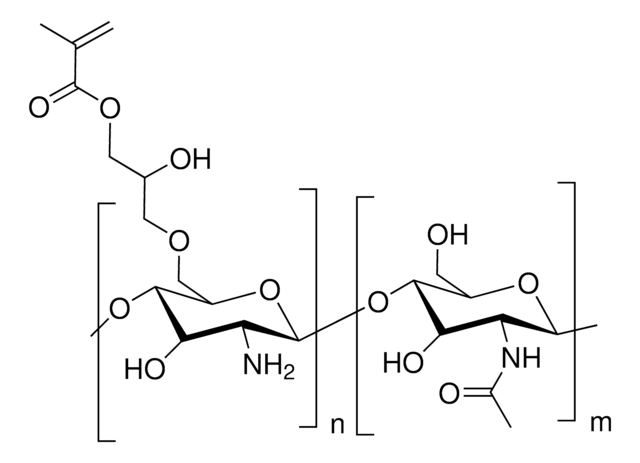923842
Alginate Aldehyde
35% aldehyde content, medium viscosity
Synonym(s):
Alginate aldehyde, Oxidized alginate
About This Item
Recommended Products
Quality Level
description
Degree of functionalization: 30-40%
form
powder
sheet resistance
15.6m Ω/sq (25 mum after curing at 150 Celsius for 5 min on glass)
color
white to off-white
suitability
conforms to structure for NMR
storage temp.
2-8°C
SMILES string
CO[C@H]1[C@@H](O)[C@H](O)[C@H](O/C(C=O)=C\C([O-])=O)O[C@@H]1C([O-])=O.OC2[C@H](OC(O)C=O)[C@@H](C([O-])=O)O[C@@H](OC)[C@H]2O
Looking for similar products? Visit Product Comparison Guide
Related Categories
Application
Alginate is commonly crosslinked into a hydrogel via ionic-crosslinking with divalent cations (e.g., Ca2+). To prevent matrix degradation, alginate can be functionalized with reactive groups that can be chemically crosslinked, such as aldehydes.[5] Aldehyde- functionalized alginate can be used to prepare hydrogels by reaction with amine groups, such as gelatin through Schiff-base reaction to form a chemical hydrogel. This material can be used in a variety of biomedical applications such as the delivery of drugs, cells, or biomolecules in different tissues, wound healing, and muscle and bone tissue engineering. [6]
Storage Class Code
11 - Combustible Solids
WGK
WGK 3
Flash Point(F)
Not applicable
Flash Point(C)
Not applicable
Certificates of Analysis (COA)
Search for Certificates of Analysis (COA) by entering the products Lot/Batch Number. Lot and Batch Numbers can be found on a product’s label following the words ‘Lot’ or ‘Batch’.
Already Own This Product?
Find documentation for the products that you have recently purchased in the Document Library.
Our team of scientists has experience in all areas of research including Life Science, Material Science, Chemical Synthesis, Chromatography, Analytical and many others.
Contact Technical Service





